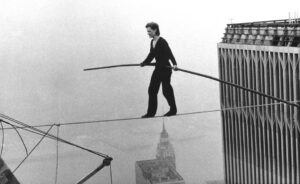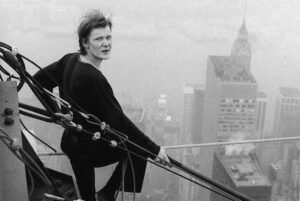
On August 7, 1984, a French man named Philippe Petit stood 1,350 feet above ground-level on the top of one of the Twin Towers. Petit successfully walked 131 feet on a high-wire between the Twin Towers with no net. The grand performance executed by this artist was unauthorized, which was why this crime was dubbed as the “artistic crime of the century”. The degree of Petit’s illegal expression of art makes him possibly the perfect example of the overlap between art and crime. Petit’s highwire walk between the twin towers would not have existed without the coexistence of art and crime.
At the young age of 18 was when Petit first began plotting “le coup” which was what he called the tightrope walk in the sky. The idea entered his head when he was reading a newspaper in a dentist’s office when he saw pictures of the planned construction of the twin towers. Petit’s reasoning for such a bizarre idea was simply “If I see two towers, I have to walk”. A total of 6 years was how long Petit spent planning and learning all he could about the twin towers and their construction. Petit’s origin story of how he came up with one of the most stunning feats an artist has ever pulled off is a spectacular representation of how a true artist will express their art even if the law does not align with how the art will be expressed. The simplicity of Petit’s reasoning is an empowering message to an audience of the world that if you want to do something that holds a meaning close to your heart, then there is no question you should do it. The dedication and commitment displayed to pull off such a feat did not deter Petit, his willingness as an artist was an inspiration to all those who witnessed his art crime.

Perhaps most incredible about Petit’s walk is the fact that he did not just walk. As if just walking from one twin tower to another was not enough, he performed for the mob of people watching from the ground and was on the high-wire for a full hour. Petit walked back and forth, saluted the sky, layed down, and even said hello to the birds. Police awaited Petit at the end of his act and arrested him as soon as Petit reached the other side. All of Petit’s charges were dropped in exchange for a free kids show in Central Park. This artist expressed his life’s work despite literally putting himself on the line and not knowing the consequences that would come after an extreme unauthorized performance. The danger, passion, and unforgiving nature of the crime is what arguably breathed a whole new meaning to the performance and made it all the more special. The enormous amount of public support Petit had was the cause of all formal charges being dropped to a crime that was objectively quite illegal.
Before Petit’s walk during this specific time in history, the twin towers were being faced with a stream of social criticism and were in financial shambles. All it took was one artist, a high-wire, and his team to completely shift the public opinion in a way that nothing else could in years. In less than an hour, on that August morning in 1984 Petit was able to turn a daunting, architecturally criticized, newly built world trade center into something that was now inviting and alluring to the public. The amount of positive impact Petit had on the world calls on a hint of irony in the way that he was somehow able to make breaking the law into an act that was as beautiful as it was unforgettable.








The first thing that stood out to me in this article was all of his charges were dropped for a simple free kids show in the park. His whole artwork and performance were almost depleted because he followed his performance for a free show in the park. I also remember a movie coming out talking about his story, and this is a further representation that if someone powerful can stand to make money your punishment for crime will be significantly lighter. I also had no idea the significance of the Twin Towers in this story, and the fact that they were failing until “the crime of the century” occurred there. People will use almost anything as a cash grab to say their product or in this case place, instead of appreciating the artwork that was there or took place there. I do think that his continual passion for tightrope walking is an interesting way to detourne or find a new use for existing things and structures already in place.
I had never heard of Petit or his tightrope performance until reading this article, and I found it to be a really interesting read! What I found most surprising about this event was not that he was immediately arrested once he came down, but rather that all of his charges were dropped in exchange for him performing a kids’ show in Central Park. I think it is really ironic that the government allowed him to do this in exchange for his dropped charges, because to me it seems as if they are helping to promote his performances even though that was the reason he was arrested in the first place. This is an extreme example of someone dedicated their life to their artistic work, as he risked his life to give people the performance of a lifetime. I also found it interesting that he made such a positive impact on the general public’s opinions on the twin towers, which is just another touch of irony on the whole situation and its legality.